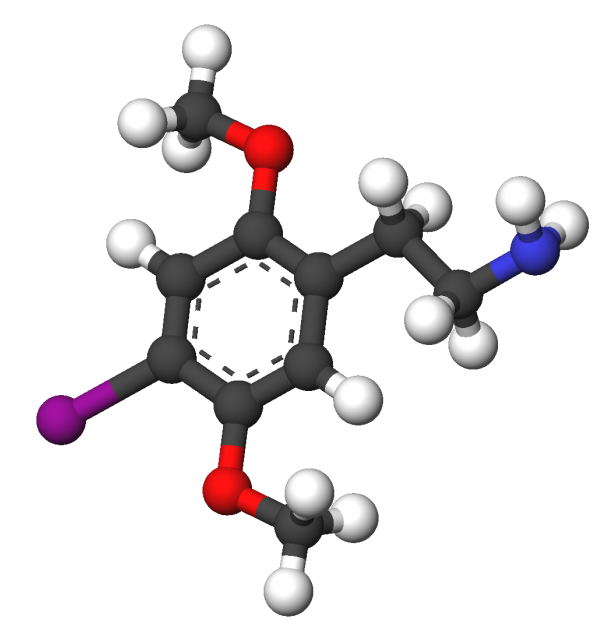Summary
2C-I is a psychedelic phenethylamine belonging to the 2C family. Alexander Shulgin originally synthesized it and extensively detailed it in his 1991 publication, “PiHKAL” (Phenethylamines I Have Known and Loved). This compound has found recreational use due to its psychedelic properties, and its effects have been reported. It’s worth noting that in some cases, it has been mistakenly associated with its more potent chemical relative, 25I-NBOMe, which is colloquially known as “Smiles” in the media.
| Identifiers | |
|---|---|
| CAS Number | 69587-11-7 |
| 3D model (JSmol) | Interactive image |
| ChEMBL | ChEMBL338297 |
| ChemSpider | 8442670 |
| ECHA InfoCard | 100.217.507 |
| PubChemCID | 10267191 |
| UNII | S35362848V |
| CompTox Dashboard(EPA) | DTXSID80893674 |

Drug prohibition laws
European Union:
In December 2003, the European Council issued a legally binding directive mandating all EU member states to enact a ban on 2C-I within three months.
Canada:
As of October 31, 2016, Canada classifies 2C-I as a controlled substance under Schedule III.
Australia:
Australia designates 2C-I as a Schedule 9 prohibited substance according to the Poisons Standard (October 2015). In the Poisons Act 1964, a Schedule 9 drug is defined as substances that may be subject to abuse or misuse, and their production, possession, sale, or use is generally prohibited by law. Exceptions are made for medical, scientific research, analytical, teaching, or training purposes with approval from the CEO.
Sweden:
Sveriges Riksdag included 2C-I in schedule I, categorizing it as a narcotic, on March 16, 2004. This was documented in the regulation LVFS 2004:3 by the Medical Products Agency.
United Kingdom:
2C-I is controlled as a Class A substance in the United Kingdom.
United States:
Effective July 9, 2012, the United States categorizes 2C-I as a Schedule I substance under the Synthetic Drug Abuse Prevention Act of 2012, rendering its possession, distribution, and manufacture illegal. A prior bill, introduced in March 2011 and passing the House of Representatives, still needs to receive Senate approval.

FAQ
1. What is 2C-I? 2C-I is a psychedelic compound belonging to the 2C family of phenethylamines, known for its hallucinogenic effects.
2. How is 2C-I typically used? 2C-I is usually ingested orally, often in the form of pills or powder. It’s important to ensure the substance’s purity and quality when obtaining it.
3. What are the effects of 2C-I? The effects of 2C-I include alterations in perception, mood, and consciousness. It’s characterized as a hallucinogenic substance, with individual experiences varying.
4. What is the recommended dosage for 2C-I? Dosage recommendations can vary among individuals, but it’s essential to start with a lower dose and titrate carefully. 2C-I is known for its potency, and finding the right dosage for individual tolerance is crucial.
5. Is 2C-I legal? The legal status of 2C-I varies by country and region. It’s important to be aware of the specific laws and regulations in your area.
6. Are there any risks associated with 2C-I use? As with any psychedelic substance, there are potential risks and side effects. These can include altered perception, hallucinations, and changes in mood and thought. Responsible use and harm reduction practices are crucial.
7. Can 2C-I be used for therapeutic purposes? Research on the therapeutic potential of 2C-I is limited, and it is not approved for medical or therapeutic use. Individuals interested in psychedelic therapy may consider legal and regulated alternatives.
8. Where can I find more information about 2C-I? Resources such as research papers, online communities, and forums can provide additional information about 2C-I. Always ensure that your sources are reliable and trustworthy.
9. What is the legal history of 2C-I in my region? The legal status of 2C-I can change over time and vary from one location to another. Research and stay informed about the specific laws and regulations in your area before considering its use.
10. Is 2C-I safe to use recreationally? The safety of using 2C-I recreationally depends on various factors, including dosage, individual tolerance, and responsible use. Like other psychedelics, it should be approached with caution and respect for its potential effects. Always prioritize your safety and well-being.
References
- In a June 2013 article published in the Journal of Medical Toxicology, Bosak, Adam; LoVecchio, Frank; and Levine, Michael discuss a case involving recurrent seizures and serotonin syndrome following the ingestion of “2C-I” (PMCID: 3657032, PMID: 23378129).
- Information regarding “25I-NBOMe (2C-I-NBOMe): Fatalities/Deaths” is available, although the source is not specified.
- Piper Weiss, in a September 20, 2012 article on Yahoo! News, highlights “2C-I” or ‘Smiles’ as a new drug of concern, particularly for parents.
- Teresa Mackin, in an article dated October 9, 2012, warns about the spread of a dangerous synthetic drug across the country, as reported on WISH-TV (archived link).
- A May-June 1999 article authored by de Boer and colleagues in the Journal of Analytical Toxicology provides more data about the new psychoactive drug “2C-B” (PMID: 10369336).
- Reuters reported on March 20, 2011, that a synthetic drug, the subject of proposed bans, led to a teenager’s death.
- Information about the legal status of 2C-I can be found in the Erowid 2C-I Vault.
- Regulatory amendments under “Part J — 2C-phenethylamines” are documented in “Regulations Amending the Food and Drug Regulations.”
- The Poisons Standard from October 2015 classifies 2C-I as a prohibited substance.
- The “Poisons Act 1964” (PDF) provides additional details about the legal status of 2C-I.
- Information about the inclusion of 2C-I in schedule I is available in “Läkemedelsverkets författningssamling” (in Swedish).
- H.R. 1254 (112th Congress) titled the “Synthetic Drug Control Act of 2011” is a bill that aimed to address synthetic drugs, although its status is not specified in this context.
- For more information, you can explore “N-(2C-I)-Fentanyl” on PiHKAL · info.
